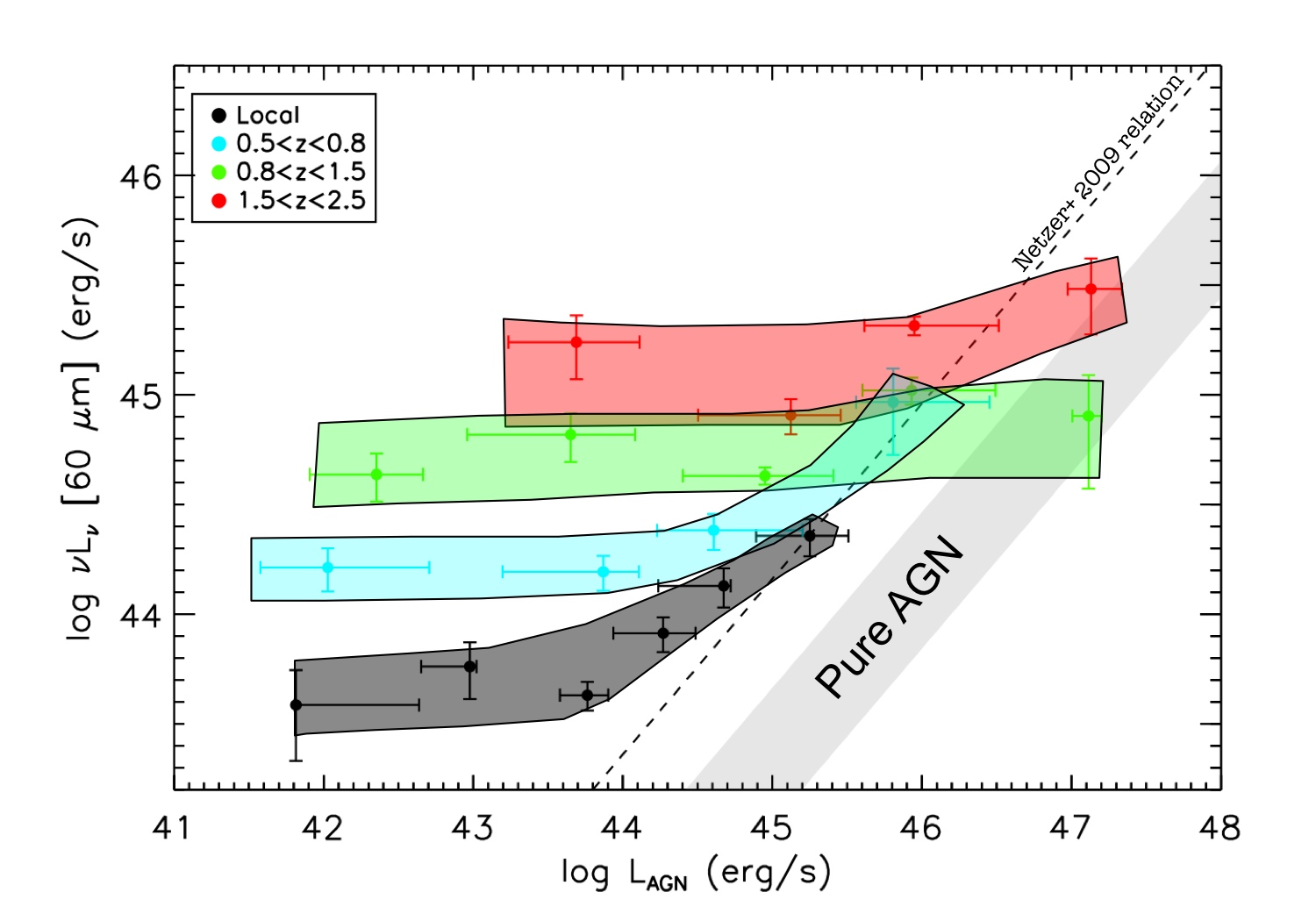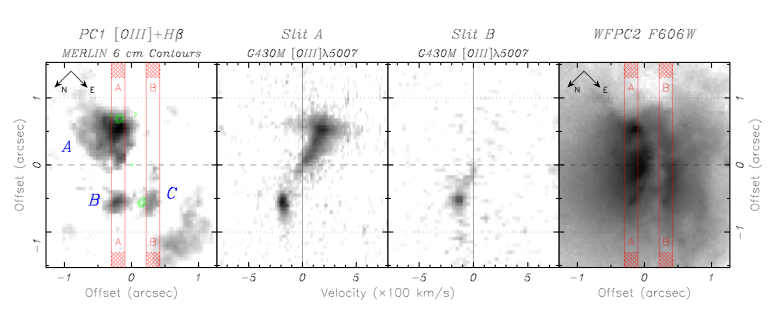Active Galaxies
Feedback in active galaxies span a range of processes which
couple the energetic output of an accreting nuclear Supermassive Black Hole (SMBH) with the
gas in the host galaxy. Under this umbrella, one may find feedback from photoionization
heating, cosmic ray and radio jet pressure, radiation pressure, magnetic and radiative disk
winds, and shock-driven acceleration and heating. My overarching research goal is to understand the detailed physics of AGN feedback, both in itself and as a force in galaxy evolution. One way is to look at galaxies where AGN feedback is at play and use the best possible data around explore what effects energy from the AGN has on the circumnuclear environment.
|
- Star formation in AGN across cosmic time
The Herschel Space Telescope has opened up the far-infrared as never before. Using some of the deepest data available from this remarkable observatory, we have looked at the average SFR (as measured by the far-IR luminosity) across redshift, AGN luminosity and obscuration. We find that the SFR of AGN hosts is not a strong function of AGN luminosity, except among the most luminous AGN at z<1 (Rosario+ 2012). We also show that AGN are preferentially found among star-forming hosts, pointing to a connection between galaxy and black hole growth that is modulated by the supply of cold gas (Rosario+ 2013a). A detailed study of QSOs shows that the hosts of these powerful AGN are in fairly normal massive SF galaxies, which is not well understood in the context of most models of AGN-galaxy co-evolution (Rosario+ 2013b, in prep).
|
 |
|
- HST imaging and spectroscopy of Seyfert galaxies with radio jets
With STIS spectra from the Hubble Space Telescope, as well as images in the optical, Near-IR and radio from HST/VLA/MERLIN, I have studied a set of local Seyfert galaxies with radio jets and emission line outflows. We uncover a great deal of complex kinematic behaviour and show the importance of such things as the gas density of the circum-nuclear environment or the presence of a gas disc in determining how the outflow and feedback from the jet interacts with the gas around the nucleus. For e.g., in NGC 5929 (see right), we show that a shock from the jet can ionize gas directly and that the jet itself can carry a large fraction of nuclear energy. (Rosario+ 2010) |
 |
|
- Double-peaked Narrow-Line AGN - What are they?
AGN with double-peaked narrow lines have opened up a new door on the discovery space of dual and binary AGN. We have studied a subset of double-peaked sources to critically test the merger/dual nature of these sources. In one well studied case (J1517+3353 - see right), we find that the double-peaked structure is due to a powerful jet-driven bipolar outflow (Rosario+ 2010). We also looked at a small sample of double-peaked AGN with laser guide star adaptive optics (LGSAO) using the NIRC2 instrument at the Keck observatory. About 30% of the double-peaked sample showed signatures of double nuclei, though clear merger signatures were rare (Rosario+ 2011).
|
 |
|
- Hosts and Outflows in High-Redshift AGN
We've looked at the hosts of X-ray selected AGN to z=3 using high resolution multi-band imaging. We show that, by and large, they are very similar to inactive galaxies of the same stellar mass at comparable redshifts (Rosario+ 2013). Tracking the [O III] line shape, we are looking at NLR outflow signatures in luminous Type II AGN from the DEEP2 survey, as well as characterizing the occurrence of this gas in neutral form from absorption lines.
|
 |
Astronomical Surveys
I am a member of several modern extragalactic survey consortia: DEEP2, AEGIS, COSMOS, PEP, CANDELS.
Abundance Evolution in Galaxies
Within the DEEP2 survey, we are using emission line calibrators of chemical abundances in ionized gas to look at metallicity evolution among SF galaxies to z=1. In addition, we are studying rare, extremely metal poor and luminous galaxies at z=0.7.



